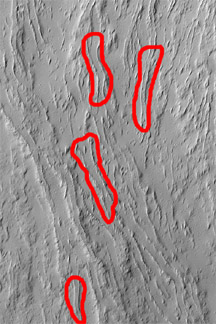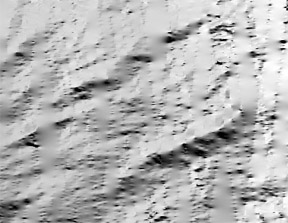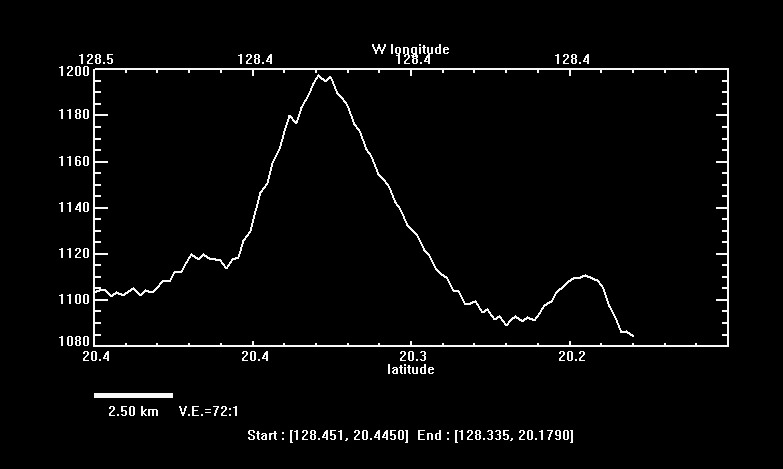 |
 |
| _______sheet
flow channels __ |
ridge flows |
Change in the Magma Chamber of Olympus Mons on Mars
Alice Enevoldsen
Whitman College, Walla Walla WA 99362
___________________________________________________________________________________________
 |
 |
| _______sheet
flow channels __ |
ridge flows |
Olympus Mons, the largest mountain in the Solar System, has been fascinating
geologists since Mariner 9 saw it poking through Mars’ dust-clouds in
1971 (Windows 2000). It is an extreme example of many geologic concepts, including
hot spot volcanism, isostatic equilibrium, shield volcanoes, lava sheet flows,
lava ridge flows, and mass wasting. Original estimates of the size of Olympus
Mons slightly overestimate its size, but new data, especially from the Mars
Observer Laser Altimeter (MOLA), allow for re-estimation of the size: 23 km
tall and almost 600 km wide (Sakimoto 1997). No one has yet used the new data
to re-estimate the flow-rates that Susan Sakimoto estimated in 1997, and hence
re-estimate the time it took Olympus Mons to be built up (Sakimoto 1997). This
is where my topic comes in; I will be estimating lava flow rates on Olympus
Mons, and determining from that the change in the magma chamber depth and composition
of the magma over time.
Background: Very little is known about the inside of Mars, even less than is
known about the inside of the Earth. Due to its almost complete lack of plate
tectonics, Mars does not have as many locations for release of excess internal
heat as the Earth, so internal heat escapes solely through volcanism (Manning
2004). This project, by examining the magma chamber, will tell us more about
the internal construction and behavior of Mars’ largest volcano, and possibly
be extendable to the other large volcanoes on the Tharsis Bulge.
We assume, as a beginning point, that Mars’ volcanoes work mostly the
same way as Earth’s: magma rises to the top of the mountain from a magma
chamber through dikes and fissures, propelled by buoyancy and pressure. As lava
erupts through the caldera it flows down the sides of the mountain obeying the
laws of gravity, friction, and cooling. With our current knowledge of the laws
of physics and geologic forces available to move magma, there seems to be no
way to pump magma up 23 km from a magma chamber below the bottom of the volcano,
where it originated (Sakimoto 2004); therefore, the magma chamber should have
risen up through the mountain as the mountain was being built. As the magma
chamber rises, it is moving through different rock than it started in, and incorporating
that into the magma being held inside it (Sakimoto 2004). That change in rock
being incorporated changes the composition and physical properties of the magma
and therefore, the physical properties of the lava flows (Sakimoto 2004).
Method: I will be attempting to answer two questions: “Did the magma chamber
of Olympus Mons change over the lifetime of the volcano?” and “How?”
To answer these questions I will be measuring the width and depth of currently
visible lava flow channels in the Mars Observer Camera (MOC) pictures, MOLA
data, visible-band images from the THermal EMIssion Spectrometer (THEMIS), and
images taken by the Mars Express High Resolution Stereo Camera (HRSC). I will
calculate flow-rates for those flows based on the width and depth of the lava
channels (with assumptions about the viscosity of the lava, friction with the
base of the channel, cooling of the magma, and how much lava is transported
the full length of the channel). I’ll adjust the flow rates for the slope
of the flow, and plot them with respect to altitude on the mountain. Assuming
viscosities similar to Hawaiian basaltic lavas, flows closer to the base should
be older; higher-altitude flows should be newer, so higher flows should have
been produced after the chamber had traveled further through the crust of Mars.
The difference in composition of the flows should show as a difference in the
physical properties of the lava and hence an observable difference in the size
and depth of the solidified lava flows. I should be able to observe these differences
in the MOLA, MOC, THEMIS, and HRSC data.
